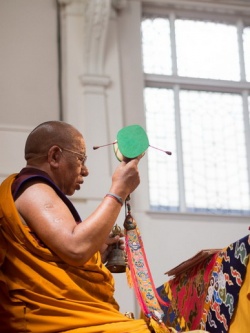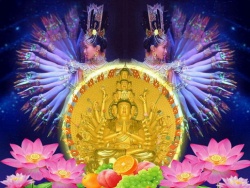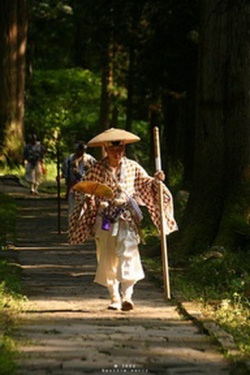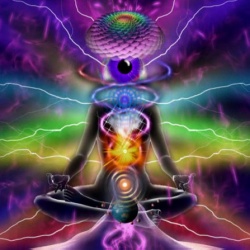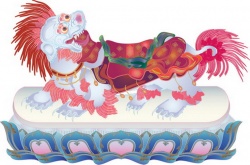Martial arts: Make yourself a soke
Satan was an angel in Heaven but he grew discontented with serving God and sought to overthrow God, so God banded Satan to Hell. In John Milton's classic work Paradise Lost, Satan says "Better to reign in Hell than to serve in Heaven." This appears to be the mantra of sokes in the martial arts.
What is a soke?
A "soke" is considered the founder of a martial art. Many "new" martial arts have been founded because a student in a martial art became discontented serving under the master of the art and wanted to be the master. Because of this, the master banded the student from the art. The student then created a new martial art and made himself a master in the art. It appears that it is "Better to reign in your own martial art than to serve in an existing martial art."
When correctly used, the Japanese term "Soke" refers, not to the founder of a specific martial arts system, but to a student who has inherited, or is named by the predecessor as the successor of, the leadership of the system. However, nowadays, the term is often used to refer to the founders of martial art systems themselves as well as to the "founders" of martial art styles.
Creating sokes
Theoretically, every martial arts system, even the very first one, whatever that may have been, had a founder, or a soke. From that one soke, now there are thousands. Why have the martial arts generated so many "Sokémons"?
One way to found a new martial art is to come up with a new way to fight, but how many different ways may a human being with two arms and two legs fight? Basically, to fight another person or animal with empty hands, a human may strike (using hands, feet, elbows, etc.) or grapple (using throws, pins, hold owns, locks, chokes, pressure points, etc.). This means you really need only two martial art systems: (System A) striking and (System B) grappling. This means you only need two sokes. However, how do you accommodate the super egos of so many martial art masters that also desire to be sokes?
You do it by creating variations of one of the original two martial arts, such as by only using kicks from (System A) and creating (Style A1), or only using throws from (System B) and creating (Style B1). Do you still need more styles? Then use parts of (System A) and (System B) to create (Style A1B1), (Style A1B2), etc. and then create versions of each of these style (Style A1B2a), (Style A1aB2b), etc.). In this manner, you may create an infinite number of styles, each with its own soke.
Why do we need so many variations anyway?
There are few other sports with so many variations, and ever fewer with a supreme master for each variation. As an example, let us examine the lowly ball. A small may be small, such as a table tennis ball, or large, such as a basketball. It may be soft, such as a tennis ball, or hard, such as a baseball. It may be round, such as a soccer ball, or oblong, such as a football. When these differences are combined with the different types of materials with which balls may be made, you come up with hundreds, perhaps thousands of ways a ball may be constructed. Now consider all the sports that use a ball for play. There are many of them, but still relatively few considering the number of types of balls that are available. Why is this?
Take the basketball for instance; it has been in use for over 100 years, why have not numerous styles of basketball play been founded. Is it because the original basketball game is so perfect that it does not need improvement? Granted there have been minor rule changes to the game through the years but it is still basically the same game as invented in 1891. Some variations of the game have been founded through the years, but they have been viewed as eclectic and useless, and have quickly passed into oblivion. Rather than change the game, basketball players have been content to play the game and try to be the best at the game that they may be. Rather than just striving to be the best an existing martial art, which will take a lot of hard work and may never occur, many martial artists simply found a martial art that conforms to their ability and declare themselves the grand master of the art.
Some may say basketball is a sport and not related to combat so it is not fair to compare it to the martial arts. Well, let us examine the handgun. Its use is certainly a combat weapon. There are currently only a few effective ways to fire a handgun in self-defense, so why has not some master founded a new way to fire it? Maybe holding the weapon upside down, firing from a one-legged stance, or maybe firing it while also firing a Tazer from the other hand. There is no reason to invent a new way to use something that works just fine the way it is.
However, in the martial arts, people feel compelled to found a new way, not necessarily a more effective or efficient way, just a new way, of doing a simple thing, such as a punch or kick. Why is this? Ego is the answer. When you are nothing special in a group of special people and you want to be a special, you create the illusion of being someone special, even if it is only within your own neighborhood. Being the founder of a new martial art makes egocentric people feel special.
Some people think different is better. The grass is always greener on the other side of the fence. It does not matter that something is ineffective or inefficient, all that matters is that it is different than that everyone else is doing. Moreover, what is better than not only doing something different, but being the founder of something different?
Progression to soke
Martial arts students start out studying a martial art of their choice. Sometimes they may change arts until they find one that best suits them, but at some point, most settle on one art. Many drop out of training after awhile but a few will train for years until they make black belt. After making black belt, most keep training for a year of two but then many drop out due to loss of interest. Some keep training and making personal progress for the rest of their lives. Some enjoy teaching others so they begin teaching. Most of those who stay with an art are content with growing the art and making it better. However, some have a desire for more power and prestige that they may attain within the art, so they make some minor change to the art, add some impressive sounding but totally useless terminology and wild unproven theories, give their creation a new impressive sounding name, and then make themselves the supreme grand master or soke of the new art.
Taekwondo itself is a mixed martial art. Its founders were black belts in karate, mostly Shotokan, who combined the Shotokan techniques with traditional Taekkyon techniques to create taekwondo. Since its beginning in 1955, it has also been a victim of masters who were not content to be merely masters of an art; they wanted to be grand masters of "their" art. Some formed new organizations but kept the name taekwondo, while others changed the name. Some made slight modifications to the art, while others made major changes. The way it stands now, if you meet a person who also studies taekwondo, you may find his or her version of taekwondo is entirely different from your own.
As stated before, every martial art had a soke at one time, even the traditional martial art systems that have been around for decades or even centuries. Some of these were probably started for the same reasons as stated above. Just because a martial art style is old does not make it any less a bogus martial art. Can you imagine a modern, or even ancient, soldier falling to the ground and fighting in the "drunken monkey" kung-fu style when facing the enemy?
Tips on how to make yourself a soke
- Obtain some training in a current martial art. No need to become proficient in it, just learn its terminology, basic movements, and theories so you may convincingly act as if you know what you are doing. Even better is to train in a number of arts for a few months each so you may claim expertise in all of them.
- Learn how to market a martial art. Watch how the McDojo organizations market their product. With good marketing, you may convince the uneducated public to believe almost anything is true. Look at the success chiropractors have had.
- Learn how to manipulate people. Some people are naturals at manipulating others, but with practice, anyone may do it. All you need is some charisma, real or fake, and no morals. Watch psychics, new age healers, television preachers, etc., they are experts at manipulating gullible people.
- Learn the standard put-downs of all the long-established martial arts. Just as with politicians, when you do not have anything real to offer, you try to discredit the opposition.
- Instead of inventing a new way to deal with an old problem, come up with some new technique and then make up a reason to use it. For example, instead of simply slipping or deflecting punches, invent a way to wave your arms around in "sticky hands" movements. Now make up a reason to use the technique, such as against another person who attacks you with little, slow pawing attacks. Then be sure to only demonstrate or use your new techniques against a fellow practitioner. Do not make the mistake of using sticky hands against a puncher.
- When your techniques do not work, make excuses. Claim it is due to "individual differences," the person was not tying hard enough, or claim it is due to some mystical reason, such as there was a diversion of ki or the moon was in the seventh house.
- Wear some outrageous looking uniform that make you look similar to a tribal chieftain or the king of a country.
- Have your students wear some cool looking uniform that is different from those traditionally worn by martial artists.
- Learn to make your most insignificant achievements seem extraordinary. Look at Senator John Kerry. He has used four months spent in Vietnam 30 years ago as a reason why he should be the commander-in-chief of all the United States military forces.
- Claim to have served in the military or military Special Forces.
- When speaking, touch people a lot. Use techniques that require a lot of touching. People feel reassured and trusting when they are touched. Many "healing" arts use this technique.
- Remember some principles of the con (politicians use these all the time):
- It does not have to be true, you only have make people believe it is true. For example, the middle class pays all the taxes, a copper bracket will heal, or ki will give you incredible powers.
- If you do not know the truth, you will be happy. For example: an unknowing wife of a cheating husband may be happy with her marriage, or a student who thinks his instructor is a great martial arts master, not knowing all the master's credentials are fake.
- If you repeat a lie numerous times, it will be accepted as the truth. For example: the natural way is better than modern medicine, or bobbing up and down similar to a fishing bob when moving will add power to your punches. The more you tell a lie, the more you begin to believe it yourself. This makes you an even more convincing liar.
- When asked an incriminating question, avoid it. Change the subject, attack the questioner's reason for asking the question, blame others for attacking your credibility, or ramble with meaningless statements until the original question is forgotten.
- Accuse others of trying to suppress your innovations. For example: oil companies buy patents for 100 mpg carburetors and keep them from the public, or accuse traditional masters of hiding to suppress your simple techniques because they want to keep students training in their schools for many years.
- Stress that new is better than old. For example, claim moving in a sine wave motion is better than the walking motion that humans have used for eons.
- Stress that old is better than new. For example, claim that holistic medicine is better than modern medicine.
- Create lots of easy to remember slogans and phrases that people may use when trying to explain your art.
- Give impressive titles to simple, routine tasks, such as calling a punch "Wary snake strikes fierce dragon."
- Always demonstrate your techniques on one of your submissive students. Do not try to use your quick knockout slap against an ordinary person; always use a person who believes you have the power.
- Always demonstrate your techniques on a stationary, passive subject. Do not try to use your pressure point attacks on a person who is moving around and resisting.
- Do not let your techniques be tested. Do not go to competitions, instead, put down tournaments as a waste of time. Say that you techniques are too deadly to use in competition.
- Never agree to perform your techniques under scientific conditions, such as using impartial subject or double blinds.
- Cover your walls with testimonials and memorabilia of your successes, no matter how minor. Get your picture taken with some local or national politician, a well-known film star or musician, or other celebrity, and hang it on your wall. All you need is the picture; you can make up a story to go with it.
- Cover walls with your life. All instructors hang their rank or instructor certification on the wall of their offices but you should also hang impressively framed certificates of every conference, course, seminar, or workshop that you have ever attended in your entire life. Also, obtain high rank certificates from every martial art you may find on the Internet. Fellow sokes will be glad to exchange rank certificates with you since it also helps them increase their credentials.
- Found your own international organization to govern your art. Never mind that your only students are in your home city or state. Such as with the Karate International organization in central North Carolina.
- Place official-looking initials behind your name. No need to earn genuine higher-level degrees, simply create your own impressive-looking initials. Use these qualifications and claims to make your business cards as impressive as possible. You can also add titles such as grand master, professor, doctor, etc. You can easily make your own certifying documents on a computer or you can order them online from some other bogus organization.
- Produce a professional website that contains every claim and testimonial that you can invent. Make frequent use of highly sensational, emotive language to sell what you have as "the greatest," "the deadliest," etc. Do not give out any useful information, make people pay for this. Many people will just accept your claims as the truth without ever verifying them.
- Publish books that claim to reveal the secret techniques of the martial arts. Rather than publish one book with useful information, publish books on each aspect of your art, such as just kicks or just throws, so you may claim to have written many books. Publishing a book is easy to do, just fill the book with photos of yourself dressed in all your regalia doing simple techniques, and with photos of someone else who is in good physical condition doing the more difficult techniques that you cannot do, and probably never could do.
- Make claims about past achievements that are difficult to verify, such as being a grand champion of numerous big tournaments. The more distant past, the better.
- Claim to be able to fight multiple attackers because you can "sense" their presence and react to their attacks.
- Invent an art that has the "best" of every other art so you may attract students interested in one of the other arts. Stress that your art is the best because it combines all the other arts.
- Apply pseudoscientific or approximately scientific tests and impressive jargon to convince your students that you really know something. Remember that anything that sounds Oriental, mystic, or similar to something shown in movies, on television, in video games, etc. will convince the ignorant that you are a true master.
- Use "power words" and eye contact along with powerful emotional speaking to make yourself more authoritative.
- Be a close speaker. Get close to people and stare into their eyes when you speak. This helps you control the person and seem powerful.
- Make your school look like a set from a "Hong Kong Phooey" martial arts movie.
- Make your facilities look as impressive as possible. Paint all kinds of oriental symbols on the wall and hang all kinds of martial arts weapons. Photos of other old, fatherly, grand masters hanging on the wall will help.
- Have at least one well-stocked bookshelf filled with books on relevant and impressive topics. You do not have to understand what is in the books or even have read them.
- Casually drop into conversation the names of well-known public figures or martial artists with whom you have met or trained with, even the most trivial meetings may be elaborated upon.
- Once students are in your program, tell them that you only teach the secret techniques to you most trusted senior students to encourage students to stay with you until that point. When that time comes, you will have indoctrinated the students into you program and there will be no need to come up with the secret techniques.
- Avoid students or people who know enough about the martial arts to question your methods.
- Only hang around with other sokes so you may support each other. Do not deal with legitimate professionals that have inquisitive, skeptical minds.
- Avoid students that have the potential of getting better than you. Stay with people with little self-confidence and self-respect, then you may mold them into you subjects.
- Ability is not of concern to pseudo-masters, it is just the art of the con. Believe it or not, a big belly and being a physical wreck is a common trait of many sokes.
- Never put down another soke. If ever asked your opinion of another soke, simply say, "She has some interesting methods," or "Yes, I have read some of his articles on the subject." In this way, you may defuse any encounters and you are not compromising your partnership without other fake sokes.
- Always include comments in your discussions about "Eastern" or "Oriental" secrets because the West seems to accept non-Western material folklore as fact.
- Pronounce karate using the Japanese pronuciation "Kuh-Rah-TAE" instead of using the American punuciation "kuh-Rah-TEE" so you sound special.
